AI in Procurement and Supplier Sourcing: Complete Guide


Key Takeaways:
You’ve probably been hearing a lot about artificial intelligence and its growing role in procurement, but you’re still not entirely sure what the buzz is all about.
Well, you’ve come to the right place.
In this article, we’re going to break down AI in a way that’s easy to understand and try to demystify the technology once and for all.
We’ll explore its benefits, challenges, and how exactly it can be applied in procurement and supplier sourcing.
But before we dive into all that, let’s take a quick look at where AI adoption currently stands within the field.
We all know artificial intelligence is the buzzword of the moment, but how many procurement teams are seriously considering using it?
According to a 2024 Amazon Business survey, a significant number.
The survey reveals that 45% of procurement professionals are looking to incorporate AI either immediately or within a year, while 80% aim to do so within the next two years.
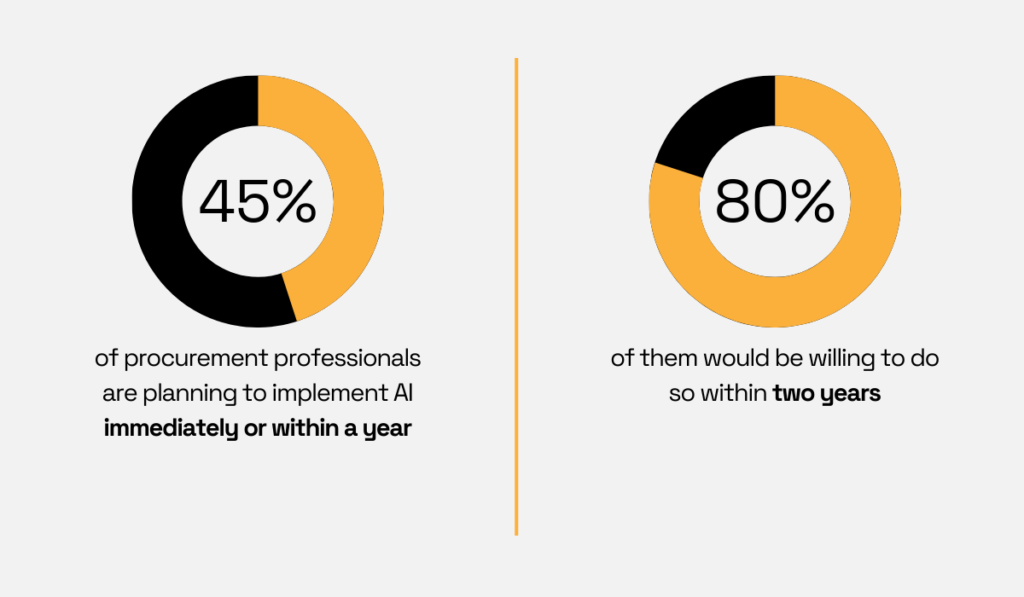
Illustration: Veridion / Data: Amazon Business
When broken down by industry, the tech sector leads AI adoption in procurement (52%), followed by telecom (51%) and medical (49%).
On the other hand, healthcare services (38%) and government (39%) sectors show the least interest.
The takeaway?
While the technology’s adoption is still in its early stages, interest is high, and most teams are gearing up to leverage it over the next couple of years.
But here’s the big question: How much of this interest is real, and how much is driven by hype?
A 2024 Keelvar survey shows that 18% of procurement teams are drawn to AI primarily because it’s the industry trend.
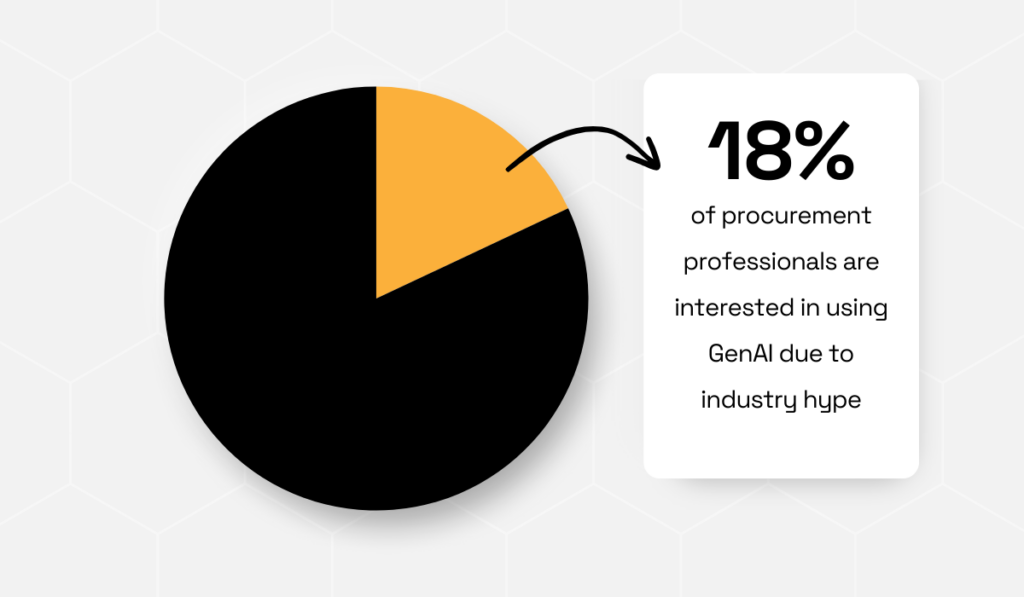
Illustration: Veridion / Data: Keelvar
This is where companies need to be careful—not to jump on the bandwagon without fully understanding the true value and applicability of AI.
Keith Hartley, CEO of LevaData, an AI-powered supply management software platform, sums it up perfectly.
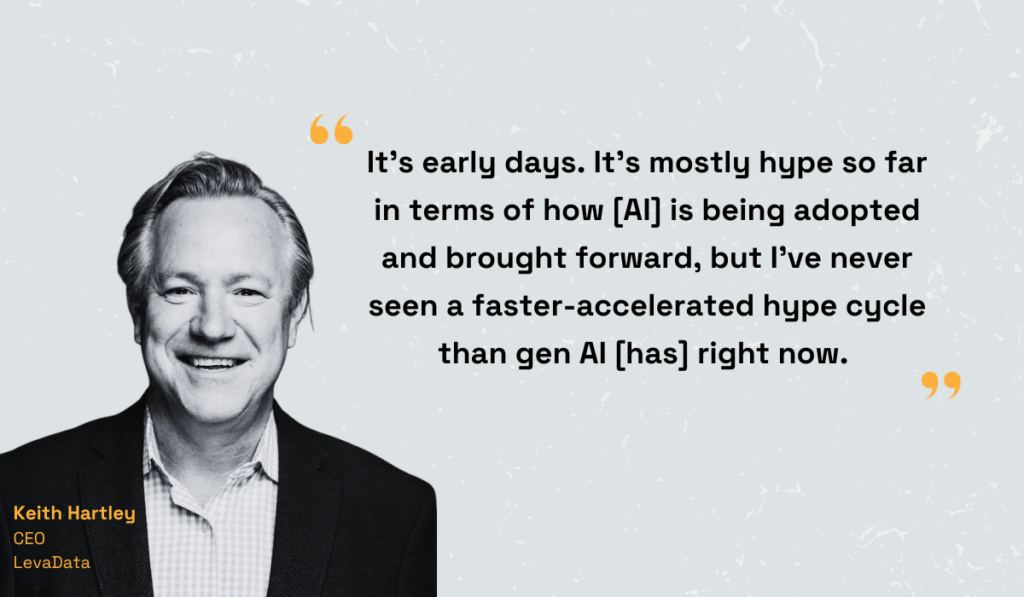
Illustration: Veridion / Quote: CPOstrategy
Yes, AI is surrounded by immense hype, but it’s not just a passing fad—it’s poised to transform procurement in a major way.
In fact, those who have implemented this technology within their operations are already seeing the benefits.
AI is set to become a huge game changer for procurement for two key reasons.
First, it dramatically improves decision-making.
Jennifer Moceri, Vice President of Global Procurement and a CPO at Google, explains why:
“With AI infrastructure, businesses can use data analytics and machine learning to make more informed decisions. By analyzing large data sets, AI can uncover trends, forecast outcomes, and provide actionable insights. This leads to more precise planning, helping organizations identify opportunities, mitigate risks, and allocate resources more effectively.”
In short, AI can process massive amounts of data from multiple sources, identify trends, predict future demand, and even recommend the best course of action—all with precision that far surpasses human capabilities.
In other words, it detects patterns human workers might miss or take much longer to see, giving procurement teams the insights they need to make smarter, data-driven decisions.
The second major perk of AI is its ability to significantly boost operational efficiency.
By automating repetitive tasks and reducing human errors, this technology minimizes disruptions and speeds up procurement processes.
Manual work simply doesn’t compare.
In fact, Ian Nethercot, a Supply Chain Director at IT procurement company, Probrand, points out that IT procurement teams lose several days each month on just one task when they perform it manually.
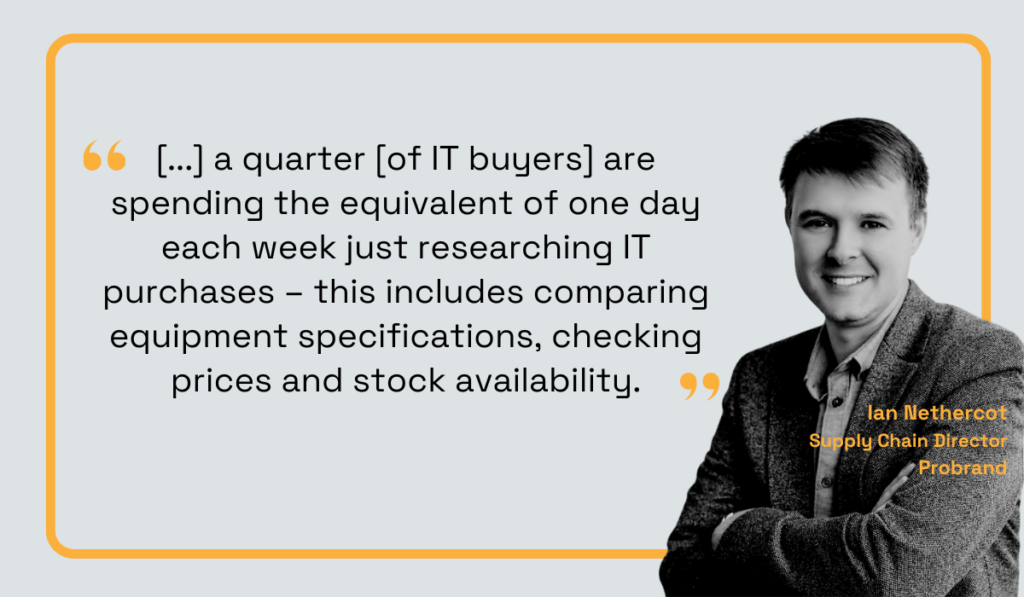
Illustration: Veridion / Quote: Technology Magazine
However, by introducing AI, those time-draining activities can finally be eliminated, allowing employees to shift their focus to more strategic, impactful work.
Just to put things into perspective, a 2021 McKinsey report found that AI-powered supplier sourcing tools can speed up supplier discovery by over 90%.
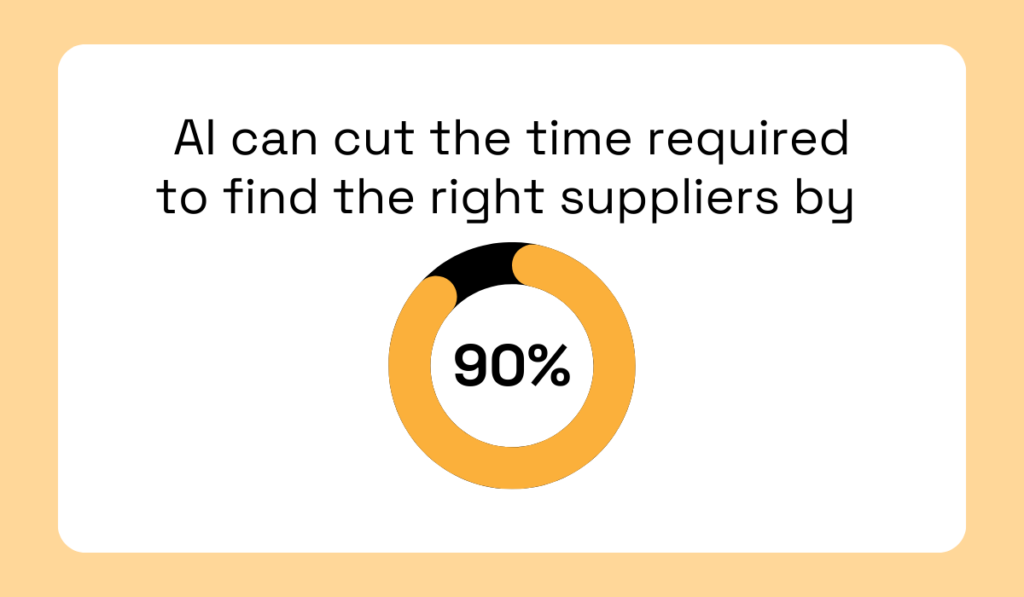
Illustration: Veridion / Data: McKinsey & Company
Now imagine applying that kind of time-saving power across all procurement activities.
The efficiency gains would be enormous.
To truly understand the benefits of AI within procurement, it’s best to look at some of its specific use cases.
That way, you can learn about how the technology works and what exactly it brings to the table.
Thanks to artificial intelligence, discovering reliable vendors and service providers from anywhere in the world has never been easier.
Take Veridion, our own AI-driven supplier sourcing tool, as an example.
With advanced machine learning models, Veridion processes billions of websites and petabytes of data every week to deliver the freshest, most accurate supplier information and help you discover vendors that perfectly fit your needs.
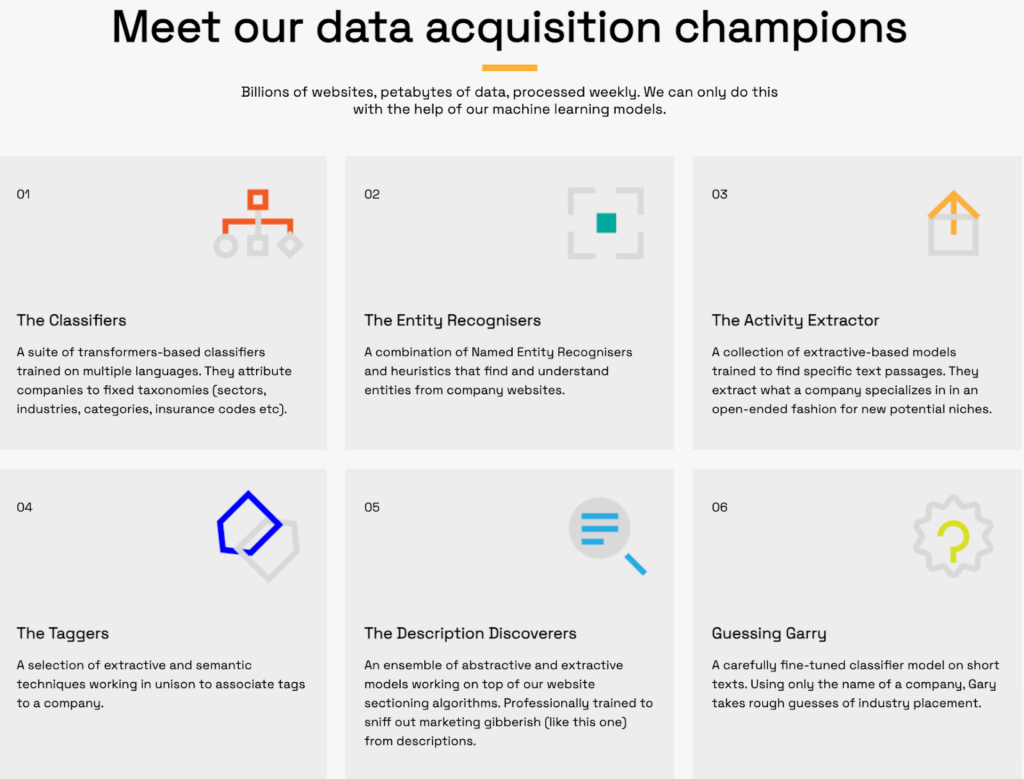
Source: Veridion
The best part?
It requires minimal effort on your end.
Simply specify your criteria, and AI handles the rest.
It taps into a constantly updated global database filled with millions of products, manufacturers, distributors, and more, instantly delivering a list of potential suppliers right to your fingertips.
You get detailed company profiles, including everything from legal names and product specifications to ESG materiality mapping, enabling you to make informed decisions with confidence.
The benefits of AI-enabled supplier discovery are immense.
For one, it offers unparalleled precision, empowering you to find exactly what you need.
Say your organization wants to focus more on ethical procurement and you get tasked with finding green steel suppliers in Asia.
With AI, you could do that without any hassle.
The map below shows all the green steel suppliers across continents Veridion was able to identify with its Advanced Search capabilities:
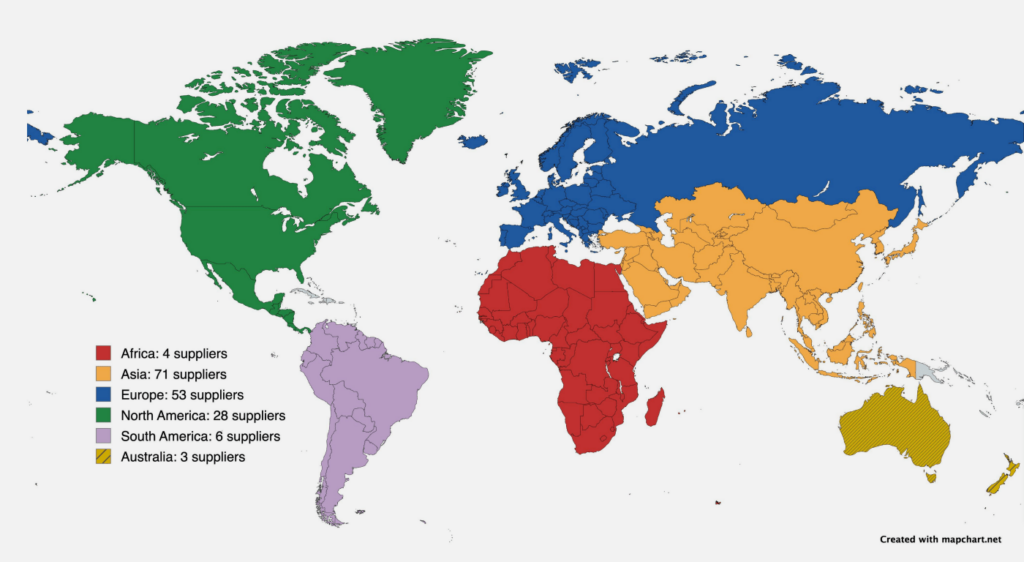
Source: Veridion
But it’s not only about precision—it’s about speed, too.
In the graph below, you can see a comparison between two workers conducting supplier discovery manually vs Veridion-powered search.
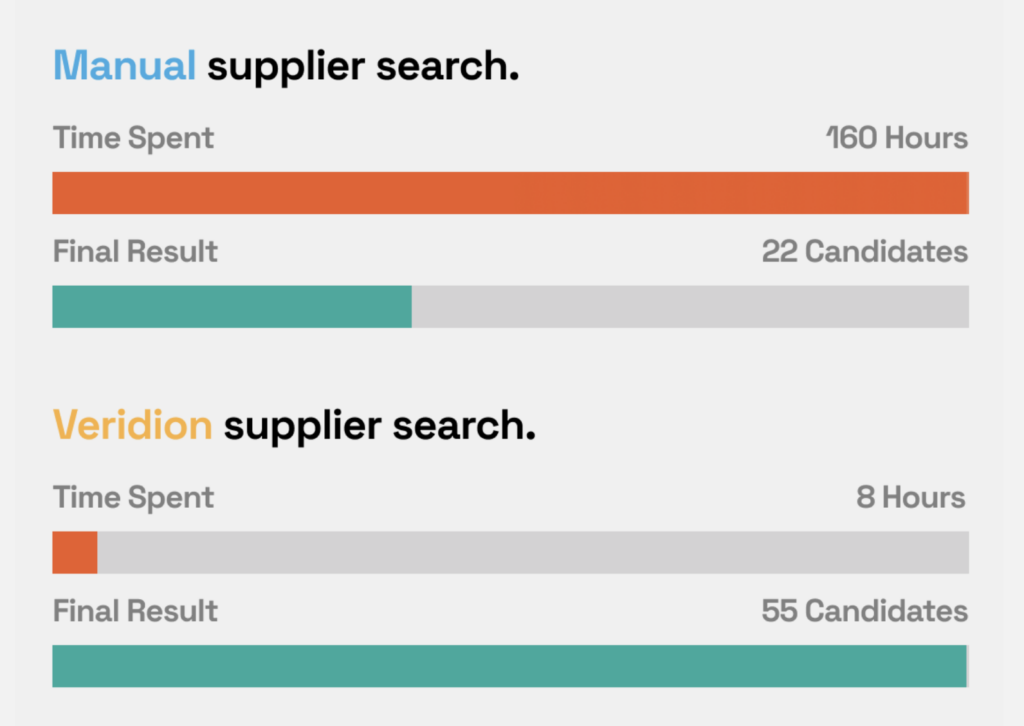
Source: Veridion
The results are pretty clear.
What took the manual process more than 150 hours, AI accomplished in just 8—while identifying even more potential candidates.
So, why spend weeks researching suppliers when AI can do it faster, better, and with much broader coverage?
More and more procurement teams are also using AI to automate various manual, time-consuming tasks across the entire procurement cycle.
One common example is RFx creation.
Traditionally, drafting, fixing errors, and defining needs for an RFx is quite a labor-intensive task.
However, AI can streamline much of this by generating templates and helping define requirements based on historical data, past contracts, or specific procurement needs.
The recorder’s office in Murray City, Utah has seen just how effective AI can be in this context.
Brooke Smith, a recorder managing procurements for the city, explains that the RFP process in general is quite labor-intensive.
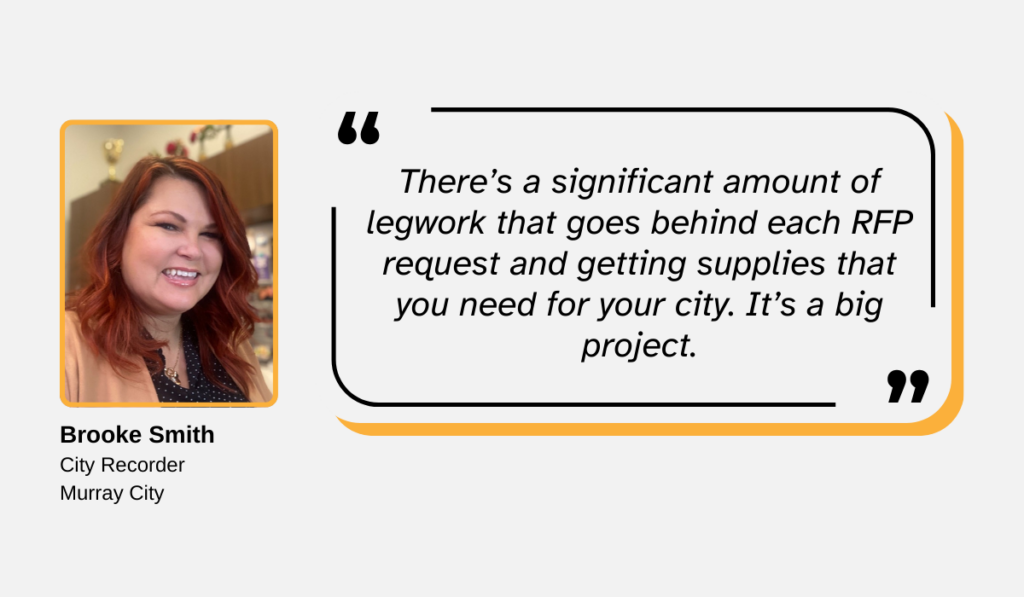
Illustration: Veridion / Quote: StateScoop
She recalls how, six years ago, her first-ever RFP for building a new city hall took five years to complete.
In contrast, when she used AI to draft an RFP for a Christmas tree last year, the difference was immediately clear:
“Had I not had generative AI, we wouldn’t have had that holiday plaza, because there’s no way I would have been able to fulfill that procurement role in the timeframe we needed.”
The request was approved the next day, a supplier was found in just 10 days, and the contract was signed by the end of the month.
Talk about efficiency.
Another area where AI works wonders is PO management.
Just like with RFx, AI can create POs automatically based on approved requests, using predefined templates and rules.
Plus, it can also streamline PO approval workflows by routing them to the appropriate stakeholders, prioritizing urgent POs, or flagging those that need special attention.
Matthew Andersen, CFO at the construction company Superior Masonry Unlimited, uses AI to match POs with invoices and is more than pleased with the results:
“The AI matched at 100% on every line on each of the 22 invoices that came in that day. Even though five of those invoices were around three pages long, the AI still matched everything perfectly. It only took me 15 minutes to review those invoices, compared to the many days it would have taken my team and me to process them manually.”
A more surprising area that artificial intelligence can automate is supplier negotiations.
Walmart, for instance, has already implemented technology from Pactum.ai for this very purpose.
Since they work with thousands of vendors and don’t have the resources to negotiate with each one individually, they deployed AI-powered negotiation software that uses a text-based interface, or chatbot, to interact with suppliers.
Source: Pactum AI on YouTube
The company inputs its budgetary constraints and goals into the system, and the chatbot, with its ability to run 2,000 negotiations simultaneously, handles the rest.
This turned out to be very effective.
So far, the chatbot has closed deals with 68% of their suppliers across the United States, Chile, and South Africa and generated an average savings of 3%.
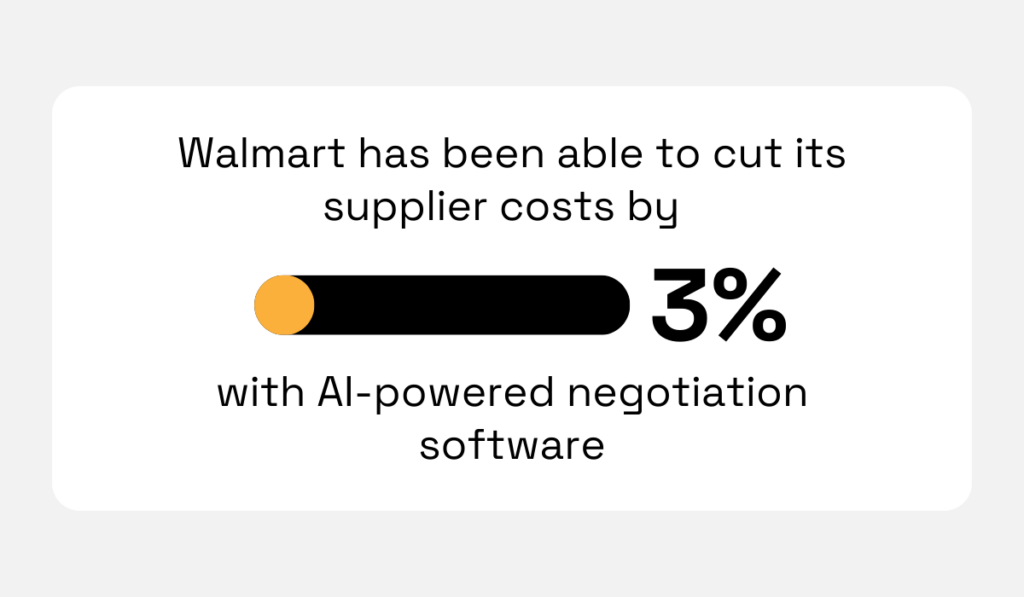
Illustration: Veridion / Data: Harvard Business Review
Ultimately, although AI already has great automation capabilities, this is likely just the beginning.
As technology continues to evolve, we can expect even more tasks and processes to be automated, making procurement faster, smarter, and more efficient than ever.
When it comes to spend analysis, AI is able to perform a wide range of tasks.
Below is a quick breakdown of everything it can do:
| Data cleansing and normalization | Removes duplicate data, fills in missing data, and formats it across multiple systems or business units |
| Data classification | Categorizes data based on keywords, web-based or community-based knowledge of suppliers, contracts, materials, and other attributes |
| Benchmarking | Compares an organization’s spending patterns, costs, and procurement practices against industry standards |
| Predictive Analytics | Predicts future outcomes based on historical or current data |
| Opportunity Detection | Recommends the best course of action |
| What-If Analysis | Generates potential scenarios based on historical and real-time data |
To sum up, AI collects spend data from various sources, such as invoices and ERPs, then cleans, deduplicates, and classifies it into a unified system.
Once organized, it analyzes the data for patterns, trends, and anomalies, like maverick spending or duplicate payments.
The results are then presented in an easy-to-understand format through dashboards, reports, and alerts, as we can see in the example below.

Source: Rosslyn.ai
This ultimately empowers procurement teams to improve their data accuracy, uncover deeper insights, and gain more control over their spending.
Take Lufthansa, for example.
In 2022, the company adopted an AI-powered spend analysis platform after their financial data—spread across 14 different ERPs—became nearly impossible to manage.
Holger König, Enterprise Architect at Lufthansa Global Business Services, explains their challenges and what they hoped to achieve with this tool.
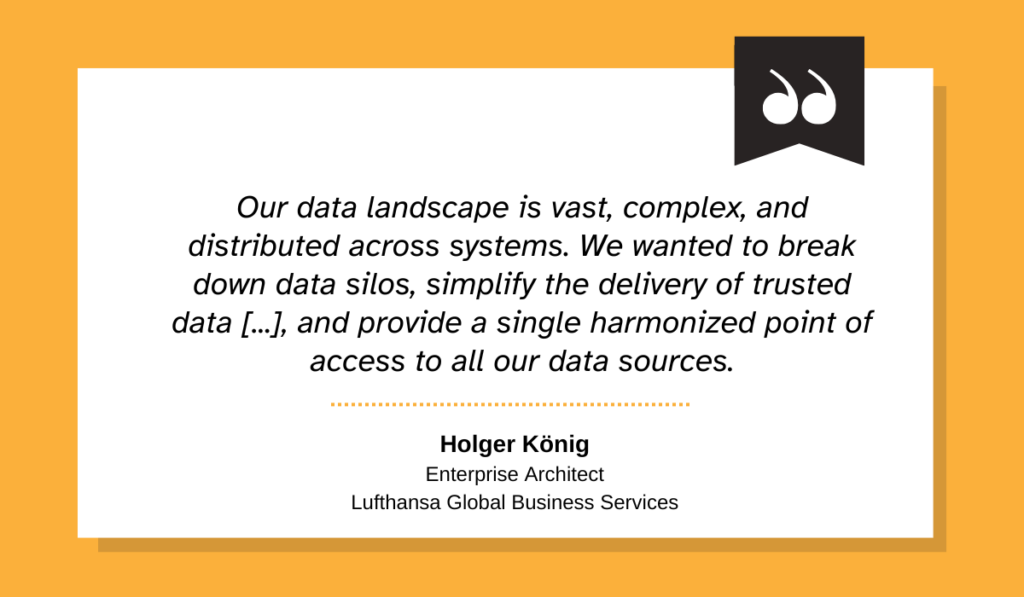
Illustration: Veridion / Quote: McKinsey & Company
And they have achieved those goals.
The new solution gave them a full, 360-degree view of their spend, improving their decision-making across the board.
For the first time, they could base their decisions on a complete, accurate picture of external costs and spend across the value chain.
Plus, AI also gave them near-real-time insights into price volatility and even carbon emissions.
Now, Lufthansa plans to roll out this technology across the entire group, expecting it to “provide better metrics across operations, including risk analytics, supplier negotiation, working capital, monitoring of material cost, and procurement performance, among other areas.”
The bottom line?
With AI, tracking and analyzing spend doesn’t have to be a pain anymore.
In fact, it can become a strategic leverage—helping companies save money, negotiate better deals with suppliers, and reduce financial risk.
AI in contract management, just like in other areas we’ve covered, aims to reduce manual effort, minimize errors, and enhance compliance.
It achieves this in several ways.
For starters, AI can automatically generate contracts using smart templates and clause libraries.
Sirion.ai is one of the tools that has this capability.
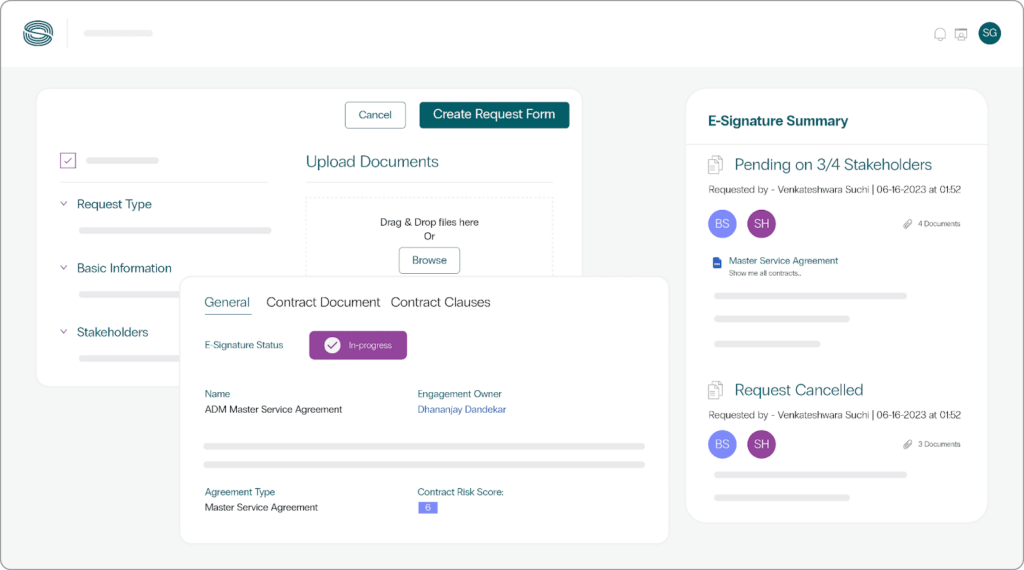
Source: Sirion.ai
More specifically, it can identify key contract elements and suggest relevant clauses based on the contract type or past agreements as well as recommend edits and changes to specific clauses.
This helps ensure contracts are always tailored to the company’s needs and in compliance with internal policies and legal standards.
But that’s not all.
AI can significantly speed up the revision and negotiation process, too.
Many contract management solutions (like the one below) now include AI-powered assistants that help you draft, redline, and summarize contracts.
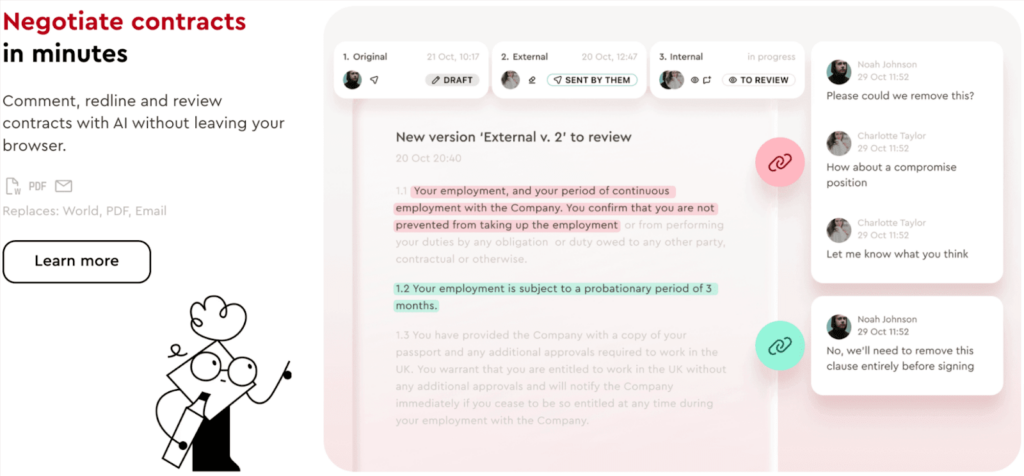
Source: Juro
And then there are automated approval workflows.
AI can route contracts, ensuring the right people sign off on time and even CC recipients when documents are signed.
No more bottlenecks or waiting around. The entire contract lifecycle just keeps moving smoothly.
The Hackett Group’s Digital World Class Matrix™ proves that AI can considerably improve contract control.
It reveals that AI-driven contract lifecycle management (CLM) can boost operational efficiency by 45% in the negotiation and supplier contract process and cut contract cycle times by 35%.
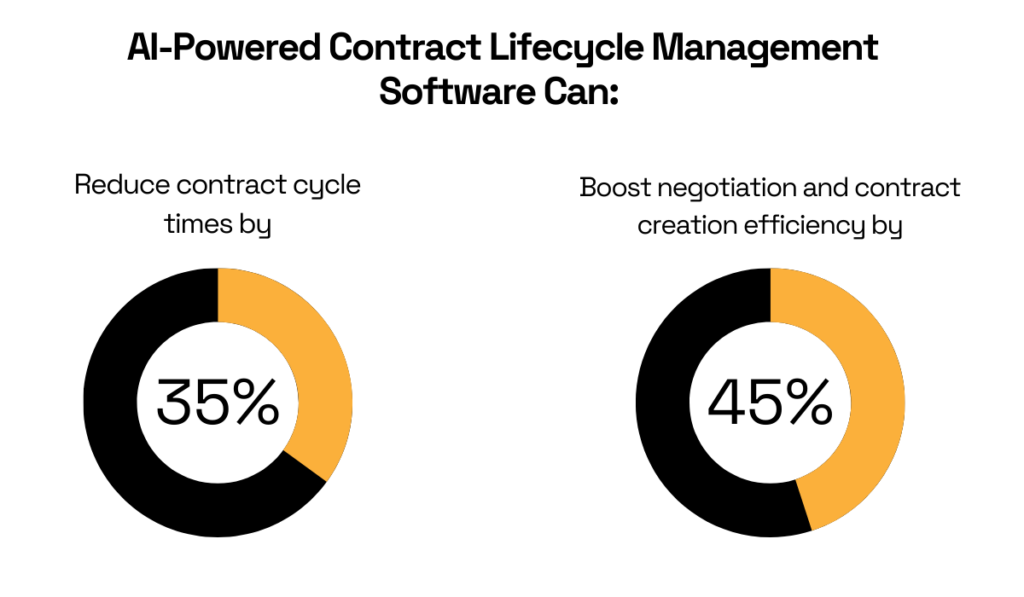
Illustration: Veridion / Data: The Hackett Group
The technology makes all this possible through automation, improved workflows, and better visibility into contract status, risks, and milestones.
Contract tracking and control have truly never been easier.
Despite its numerous benefits and versatile use cases, not everyone is on board with artificial intelligence.
So, let’s explore some of the common hurdles holding procurement professionals back from fully embracing this technology.
One key concern is data quality.
AI models rely on high-quality data to make accurate predictions and decisions.
However, procurement data doesn’t always meet this criterion as it’s usually scattered across different systems, and can be incomplete, unstructured, or outdated.
And when AI is fed bad data, the results are just as bad, rendering the system ineffective or even counterproductive.
Therefore, it’s not surprising that more than half of procurement officers are concerned about the need for continuous monitoring and correction of AI systems.
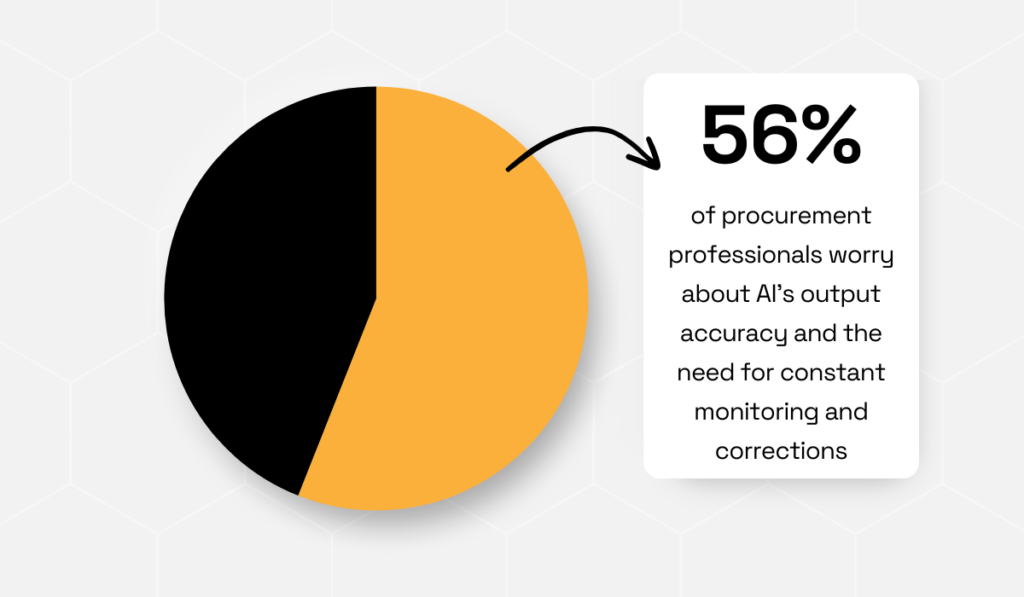
Illustration: Veridion / Data: Keelvar
But that’s not the only challenge.
Sometimes, the resistance to AI comes from a deeper reluctance to change.
Whether it’s fear of job displacement or simply being uncomfortable with new tech, people can be slow to adapt.
In fact, a survey by Ivalua found that 28% of procurement leaders see user resistance as one of the top barriers to adopting generative AI.
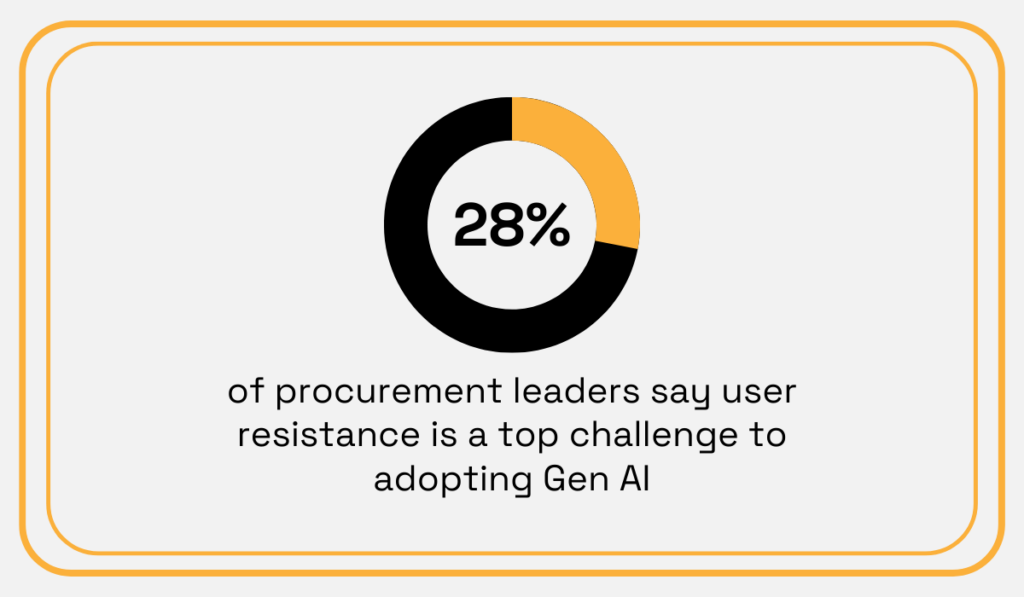
Illustration: Veridion / Data: Ivalua
After all, without the team’s buy-in, even the best technology won’t make any impact.
While all of these concerns are valid, companies shouldn’t completely close themselves off to AI.
It’s far wiser to adopt the mindset of Ashish Gupta, Director of Procurement at The Clorox Company, an American global manufacturer of consumer and professional products:
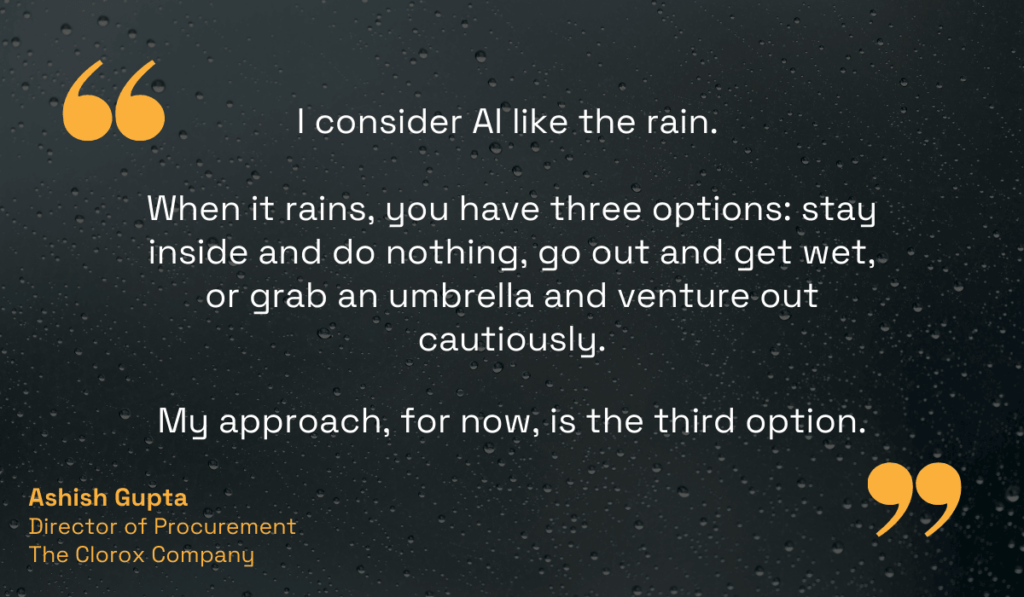
Illustration: Veridion / Quote: Zip
In other words, tread lightly and embrace AI thoughtfully and strategically.
You can take it as slowly as you want, but don’t ignore its potential to take your operations and decision-making to a whole new level.
Hopefully, this article has made AI less intimidating and highlighted its potential.
Yes, we’re still in the early days, and there are some challenges to tackle, but, generally, the future of AI looks promising. Its use in procurement is definitely set to grow.
Why wouldn’t it?
AI is versatile, efficient, and can make many tasks easier.
And while the technology handles cumbersome, time-consuming activities, procurement professionals can focus on what truly matters—driving innovation and bringing companies closer to their goals.